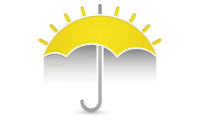What do these industrial casualties have in common? It was a hot midsummer afternoon; the humidity was unusually high; and the cause of the incident was determined to be a condition known as heat stress.
While often overlooked as a workplace hazard, heat stress represents a significant risk in industries where workers must engage in physical activity of any intensity, from light to very heavy. Moreover, heat stress can significantly increase the possibility of other safety incidents. For example, coping with excess heat can result in deterioration of motor skills, judgment, and concentration. When this happens, the safety of the individual, as well as the work group, may be in peril.
A common risk
Although the above safety scenarios are fictional, they show that hot, humid conditions can be frequent visitors to workplaces of all types. This is true not only in southern climates, but in most sections of the country. An analysis of average temperature and humidity readings in cities across the U.S. shows that the potential for heat stress is widespread and not limited to only the hotter, more humid regions. Indeed, heat stress is a very common problem, and a heat stress management plan is a prudent safety measure regardless of the geography or climatic history of the worksite or the nature of the clothing worn by employees.Such a plan (see sidebar) may require specific engineering controls and changes in work procedures that can be easily adopted to reduce the potential for exposure. In extreme cases, the planning discipline may indicate that special personal protective equipment (PPE) is necessary, such as heat-reflective garments or water-cooled work suits.
Guidance in developing a preventive heat stress management plan is contained in the OSHA Technical Manual available from the Occupational Safety and Health Administration’s Web site on the Internet: www.osha.gov.
What is heat stress?
Heat stress is the condition experienced by the body as it struggles to withstand the buildup of excessive internal heat. Serious stress can develop as the body’s self-regulating “thermostat” fails to maintain body temperature at its normal level. This usually occurs when the employee is exposed to a high-heat, high-humidity environment for an extended period of time.Heat stress can be caused by factors in the workplace or by season of the year. It can occur anywhere the weather is hot and humid. In addition, the individual employee’s work habits, physiological makeup and wearing apparel may also contribute to the development of heat stress.
The effects of heat stress can range from minor to life-threatening. A rash is often the first sign of workplace conditions that lead to heat stress; fainting and heat exhaustion may result if the conditions persist. Prolonged and severe heat stress may lead to serious injury or even death.
The American Conference of Governmental Industrial Hygienists (ACGIH) defines heat stress as:
“The net heat load on the body from the combined contribution of metabolic heat production and external environmental factors, which include air temperature and water vapor content, radiant heat exchange and air movement, as these are affected by clothing.”
To define acceptable limits of heat stress, the ACGIH has published recommended heat exposure threshold limit values (TLV®s) for different levels of work activity, from light to very heavy. More information on these values and their use in a heat stress management plan can be found in the OSHA Technical Manual and in the publication 1999 TLVs and BEI®s available from the ACGIH, 1330 Kemper Meadow Drive, Cincinnati, OH 45240-1634.
James P. Zeigler, Ph.D., is a research associate in DuPont’s Tyvek® business, providing market support and product development for Tyvek® protective apparel and Tychem® chemical barrier fabrics. Dr. Zeigler currently serves as chairman of the particulates subcommittee on the American Society for Testing and Materials (ASTM) Committee F23 on Protective Clothing .
Note: This information is based on technical data that DuPont believes to be reliable. This information is subject to revision as additional knowledge and experience are gained. DuPont makes no warranties, express or implied, including without limitation, no warranties of merchantability or fitness for a particular use. DuPont assumes no obligation or liability whatsoever in connection with any use of the information contained in this article. This information is not intended as a license to operate under or a recommendation to infringe any patent or technical information of DuPont or others covering any material or its use.




